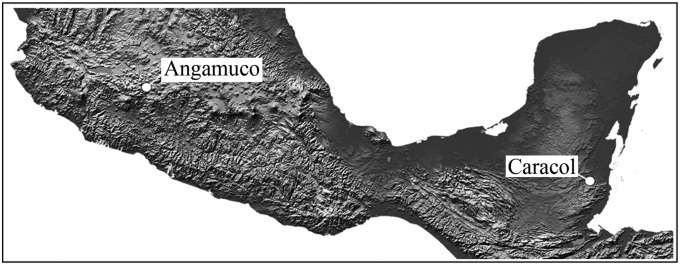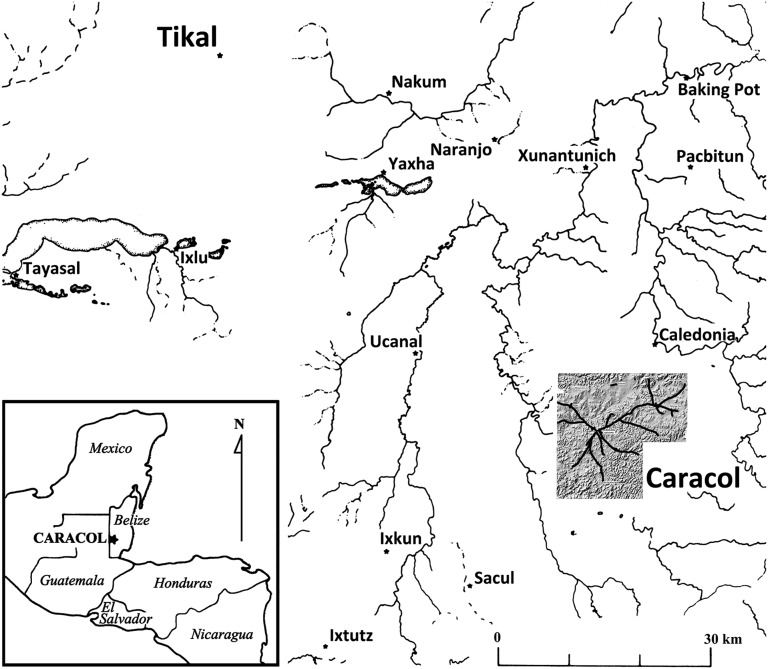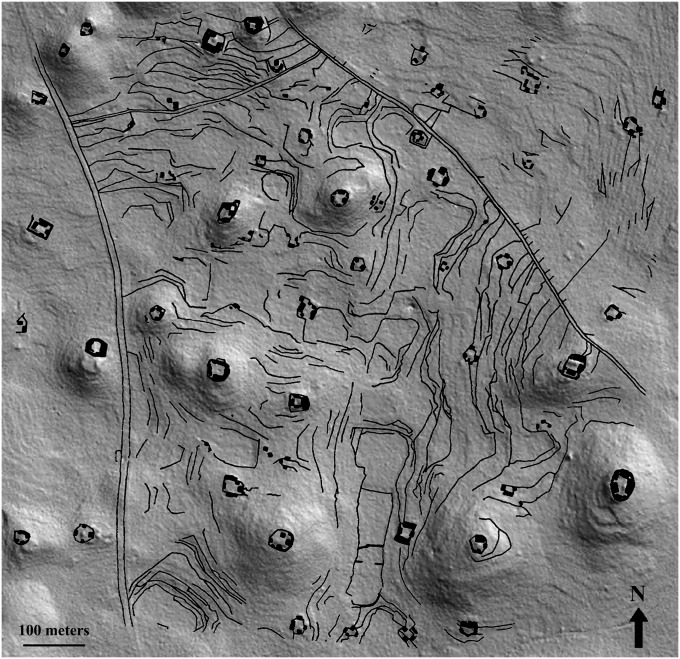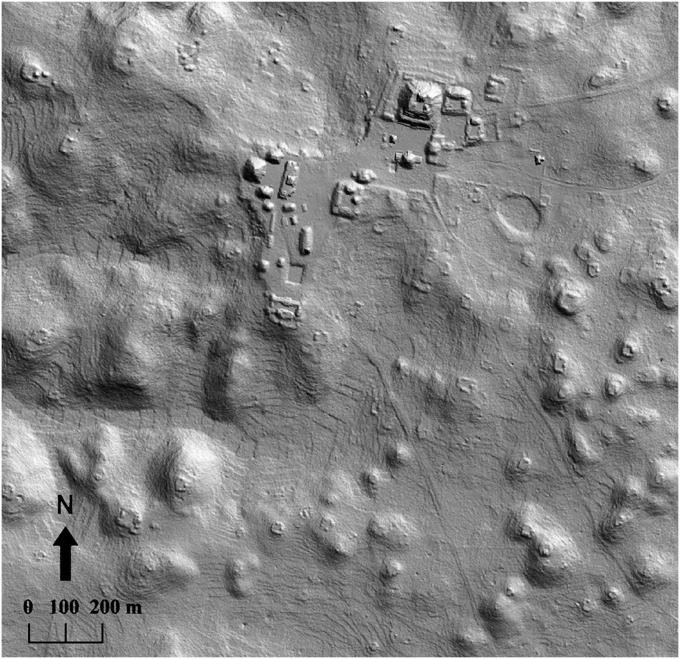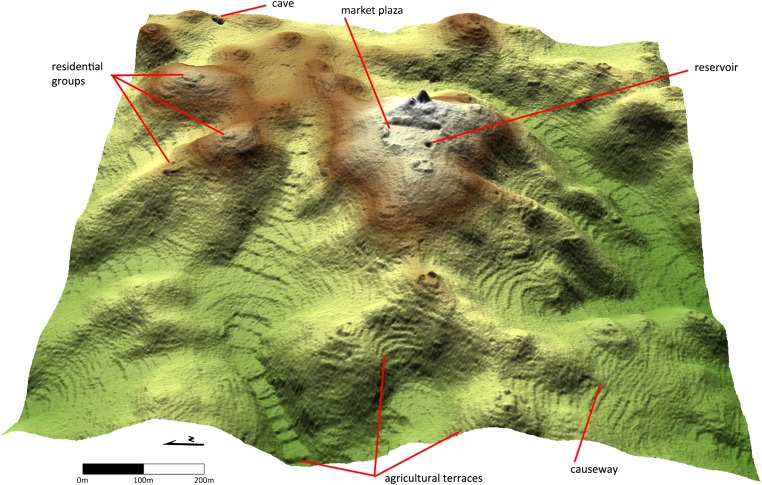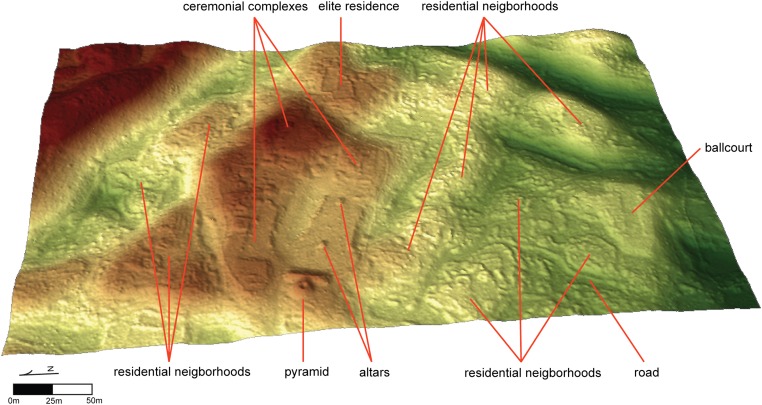Abstract
The application of light detection and ranging (LiDAR), a laser-based remote-sensing technology that is capable of penetrating overlying vegetation and forest canopies, is generating a fundamental shift in Mesoamerican archaeology and has the potential to transform research in forested areas world-wide. Much as radiocarbon dating that half a century ago moved archaeology forward by grounding archaeological remains in time, LiDAR is proving to be a catalyst for an improved spatial understanding of the past. With LiDAR, ancient societies can be contextualized within a fully defined landscape. Interpretations about the scale and organization of densely forested sites no longer are constrained by sample size, as they were when mapping required laborious on-ground survey. The ability to articulate ancient landscapes fully permits a better understanding of the complexity of ancient Mesoamerican urbanism and also aids in modern conservation efforts. The importance of this geospatial innovation is demonstrated with newly acquired LiDAR data from the archaeological sites of Caracol, Cayo, Belize and Angamuco, Michoacán, Mexico. These data illustrate the potential of technology to act as a catalytic enabler of rapid transformational change in archaeological research and interpretation and also underscore the value of on-the-ground archaeological investigation in validating and contextualizing results.
Keywords: Maya, Mesoamerica, paradigm shift, remote sensing, digital elevation model
Transformational changes are rare in archaeology and often are best recognized in hindsight (1). However, there are times when advances in technology are so far reaching that they serve as catalysts in transforming our understanding of both the past and the practice of archaeological research, thus triggering a scientific revolution as conceptualized by Thomas Kuhn (2). We believe that advances in the remote geospatial imaging of cultural landscapes, including ancient communities and their anthropogenic hinterlands, constitute such an archeological paradigm shift. Here we present newly acquired data from two recent archaeological projects in different parts of Mesoamerica showcasing the application of light detection and ranging (LiDAR) technology to ancient urban settlements. In both cases, the nearly 3D data are changing commonly held interpretations of societal development profoundly. The phenomenon described is not limited to archaeology; technical innovations have been noted as spawning advances in other areas of research, such as astrophysics (3). However, the magnitude of change enabled by the use of LiDAR technology is particularly apparent in the archaeology of Mesoamerica.
Archaeological research revolves around temporal and spatial data; thus, advances in either parameter can be transformative. Histories of archaeology (1, 4) have noted the change in the discipline from an ancient antiquarian focus on objects to the current scientific enterprise. Great enablers of archaeological research have included various technological enhancements to spatial, temporal, and functional interpretations. Although many technical improvements, ranging from the use of total stations to digital photography, have been used in archaeological research, by far the greatest technological enabler of the 20th century was radiocarbon (C14) dating, which allowed the first absolute dating of past events and activities. Radiocarbon dating sparked an archaeological paradigm shift by providing absolute dating of ancient deposits and settlements, thus permitting the scientific detailing of relationships among sites, cultures, and people. Subsequently developed dating techniques (e.g., K-Ar dating, obsidian hydration, thermoluminescence) have extended temporal interpretations.
Like radiocarbon dating, LiDAR is changing the nature of archaeological research fundamentally. Lasers and LiDAR technology facilitate detailed study of large areas of terrain, including those obscured by heavy vegetation. This technology permits archaeologists to document the landscape in the same way that it is experienced by people—in multiple dimensions. LiDAR produces a huge volume of 3D (x, y, z) measurements, called “point cloud data,” that promise to transform our understanding of past societies and the landscapes they manipulated, thus assisting in discussions of settlement, site scale, and regional integration. Importantly, LiDAR-derived data act as a permanent horizontal and vertical document of everything on the landscape—archaeological remains, vegetation, topography—at the time the data are collected, thus also recording the status of site preservation and looting, deforestation, and modern construction at a single point in time. Although these developments are applicable world-wide, here we discuss them specifically in the context of Mesoamerican archaeology (Fig. 1).
Fig. 1.
Location of the ancient cities of Caracol, Belize and Angamuco, Mexico within greater Mesoamerica (topography derived from National Aeronautics and Space Administration/National Geospatial Agency/US Geological Survey).
Archaeological remains traditionally are defined in terms of time, space, and style. Without absolute dating, style was useful for defining related archaeological materials, but positioning defined units of style in time often proved problematic. Concerns over chronology dominated much early archaeological work in various parts of the world (5–7), especially because often it was difficult to relate spatially separated archaeological remains to each other. Although stratigraphy and seriation could be used to provide relative dating for past remains, cross-dating between sites was challenging.
The initial sequencing of archaeological cultures in Mesoamerica occurred in the Valley of Mexico, where Gamio (8) was able to show that “Archaic” was stratigraphically earlier than “Teotihuacan,” which was stratigraphically earlier than “Aztec.” Eventually, a “Toltec” horizon was placed between Teotihuacan and Aztec, thus establishing a basic framework for the interpretation of central Mexican archaeological remains. However, outside the Valley of Mexico, it was not always clear how sites, peoples, and cultures related to each other. In the Maya area an independent chronological sequence was established stratigraphically at Uaxactun, Guatemala in the 1920s (9, 10). However, the resulting artifactual groupings, or “styles,” were positioned in time only relative to each other (11). How far back they went, how long they persisted, and how they related to other archaeological regions in Mesoamerica was largely unknown. Even in areas where dendrochronology was available, most defined archaeological assemblages could not be positioned confidently on an absolute temporal scale. Thus, dating remained a paramount challenge for archaeological research and a problem that was not resolved fully until the 1950s. Radiocarbon dating had a profound effect on archaeology because it provided secure time depth and finally permitted ancient materials to be related to each other dependably in absolute time (12, 13).
In the Maya area, radiocarbon dating ultimately resulted in agreement to adopt one specific calendric correlation for Maya hieroglyphic dates, whereas previously a multitude of possibilities had existed. Based largely on the fit with radiocarbon dates, a single correlation, the Goodman–Martinez–Thompson or “11.16.0.0.0 Correlation” (14, 15), was accepted as the most appropriate alignment of the ancient Maya hieroglyphic record with our modern-day calendar, finally allowing comparisons among sites and regions. This correlation positioned the Classic Maya Collapse at approximately A.D. 900. Radiocarbon dating in the Maya area also significantly pushed back the beginning of that civilization (16, 17) and resulted in the recognition of early complex developments by 1000 B.C, challenging models for the later development of Maya civilization (18). Elsewhere in Mesoamerica, radiocarbon dating helped place the Olmec in the Middle Preclassic Period at La Venta, Mexico, dating from 800 to 400 B.C (19), rather than in the Terminal Classic–Postclassic Period as previously had been argued stylistically (20). This earlier dating of the Olmec highlighted their temporal precociousness and led to new debates over their impact in Mesoamerica (e.g., refs. 21 and 22). Thus, this technological advance spawned movement to an agreed-upon alignment of indigenous calendar systems and the appropriate positioning of diverse styles and cultural developments across a broad geographic area, allowing a better understanding of that cross-cultural interactions.
Currently, technological advances are leading to a geospatial revolution and a second period of rapid change in archaeology, one focused on outlining large-scale natural and human-built landscapes. The effects of this technology are being felt most clearly in forest-covered areas of Mesoamerica where ancient landscapes traditionally have been most difficult to define. Just as radiocarbon dating transformed the temporal domain, the current geospatial innovations are bringing a semblance of control to the spatial domain and are helping significantly with the interpretation of past sociopolitical complexity.
Settlement and landscape archaeology have formed key building blocks for the study and reconstruction of ancient human occupation and interaction with the environment (23, 24). These approaches have altered the way archaeologists view ancient civilizations by focusing on both small and large sites, by showcasing urbanism, and by pointing to fallacies in views of settlement density and agricultural practices (25–28). However, the impact of settlement and/or landscape archaeology has been limited in areas that are heavily forested, where on-the-ground survey and the use of traditional remote sensing techniques can be difficult and unreliable. Past mapping efforts, especially in the Maya area, generally covered only a limited sample of any single site and rarely contextualized settlement in terms of its overall landscape (28), so that nonarchaeological data often took precedence in establishing sociopolitical models. Our spatial knowledge of parts of Mesoamerica that were less heavily vegetated, such as the Valley of Mexico (29) and the Valley of Oaxaca (30–32), is much greater than that of the generally jungle-covered Maya region. To some degree, this difference in knowledge has led to a long-standing imbalance in our understanding of scale and complexity in the Maya area compared with many parts of the Mexican highlands.
Ethnohistory, iconography, and ancient documents have all been used to try to explain the ancient sociopolitical and economic organizations once extant in Mesoamerica, but these data sets are limited in what they can accomplish. The late 15th and 16th century European accounts described peoples whose activities and sociopolitical institutions had been changed greatly by contact and disease. The breakthroughs in epigraphy that occurred in the 1990s significantly advanced interpretations about the ancient Maya, but texts dealt only with a small segment of ancient Maya populations. There was a disconnection between much of the epigraphy, which focused on events in the lives of “kings and queens,” and the archaeology, which reconstructed past day-to-day ways of life (33). Models based on epigraphy focused on dynasties and hegemonic empires (34), but what these units actually looked like on the ground only could be conjectured. Because the spatial parameter was not fully controlled, a multitude of sociopolitical models proliferated. Long-standing questions about Maya urbanism (35, 36), their ancient population sizes (37), and the structure of their states (38) remained unanswered, with some researchers insisting that the Maya were not especially developed (39, 40) and others arguing for a range of complex systems (41). Similar issues, largely driven by ethnohistory and not epigraphy, existed in the highlands of Mesoamerica, especially in regard to the extent and role of Tula in central Mexican developments (42). The lack of concrete spatial parameters and the limited samples gained from archaeological sites made it extremely difficult to know which sociopolitical models were appropriate. However, this imbalance is being remedied, in part by the application of LiDAR technology that can penetrate forest and scrub canopies to record landscapes and archaeological ruins accurately at high spatial resolution. The more complete LiDAR data demonstrate that some ancient Mesoamerican sites are far more extensive and complex than was thought possible following popular sociopolitical models (43).
Results and Discussion
The initial test of LiDAR in the Maya area was undertaken by the National Center for Airborne Laser Mapping at Caracol, Belize in April 2009 and yielded spectacular results (28, 43–45). The LiDAR data from Caracol provide a view of an integrated Maya urban center that covers ∼200 km2 (Fig. 2). Importantly, these data can be ground-truthed through comparison with 23 km2 of transit-mapped settlement (46, 47) and more detailed mapped areas of ancient agricultural fields (48). Superimposing previously surveyed areas of housing, administrative and ritual constructions, agricultural terracing, and causeways on LiDAR digital images showcases the accuracy of the methodology (Fig. 3). The decades of collected archaeological data from Caracol provide both temporal and functional contexts for the newer LiDAR data, permitting both an understanding of how the anthropogenic landscape evolved and a dating of A.D. 700 for the occupational peak of the archaeological remains (28, 43). LiDAR not only is successful in “seeing” the larger architecture and roadways in the site epicenter (Fig. 4) but also accurately portrays very low constructions, outlying architectural nodes, and the magnitude of agricultural terracing throughout Caracol (Fig. 5). Even small openings into the ground that represent underground storage units (called “chultuns”) and looted burial chambers in structures are visible; a large number of caves similarly have been detected and ground-checked (49).
Fig. 2.
The 199.7-km2 DEM for Caracol shown in relation to other known sites in the southeastern Maya lowlands, illustrating a change in the perception of the scale of a Maya site from a single point on a map to a large anthropogenic landscape. Caracol’s causeway system showing the spatial integration of the site is visible within the DEM.
Fig. 3.
Previously mapped square-kilometer area of Caracol settlement and terraces superimposed on a 2D hillshade of the LiDAR DEM, showing congruence. Causeways are visible to either side; residential groups were mapped throughout the square kilometer, but before the LiDAR survey agricultural terracing was recorded systematically only between the two causeways.
Fig. 4.
A 2D hillshaded image of central Caracol and outlying settlement demonstrating the ability to see in great detail the structures, residential groups, causeways, terracing, reservoirs, sinks and caves beneath the tropical canopy.
Fig. 5.
A 2.5D colorized, hillshaded image of Caracol’s Puchituk Terminus showing the magnitude of the landscape manipulation and agricultural terracing undertaken by the ancient Maya.
This single Digital Elevation Model (DEM) laid the groundwork for a transformational shift in Maya archaeology by providing for one Maya site a complete landscape rather than merely a sample of the settlement that could not be fully contextualized. Although previously it had been possible to dismiss the size estimates for Caracol as being based on selective sampling (e.g., ref. 50, pp. 234–236), the LiDAR results confirmed and visually demonstrated Caracol’s scale (28). The LiDAR provides a full view of the 200-km2 area of Caracol, depicting a sprawling Maya city replete with markets, roads, and almost continuous agricultural terracing, thus corroborating the archaeological data that indicated a massive population focused on sustainability and site-wide integration. These data securely place Caracol, presumably along with some other ancient Maya cities, into a tropically defined phenomenon known as “low-density urbanism” (51, 52).
A further application of LiDAR was made in 2011 over the site of Angamuco located within the Lake Pátzcuaro Basin in west-central Mexico (53). The results here were as successful as the Belize application. An area of 9 km2 was overflown, uncovering an exceedingly dense urban occupation in this prehispanic Purépecha (Tarascan) region. The form and layout of Angamuco revealed by the LiDAR data show a site that has hundreds of residential groups bounded by walls and streets that articulate with larger, distinctively Purépecha, monumental architecture (Fig. 6). Like Caracol, previous survey data from Angamuco shows a high congruence with the LiDAR data as well as a largely human-constructed environment. However, the scale and organization of this settlement was not expected and is contrary to current models of complex social development in the region (e.g. ref. 54). The Angamuco residential settlement closely resembles residential patterning seen at the site of Cantona, Puebla in east-central Mexico (55), considered to be anomalous for that region.
Fig. 6.
A 2.5D colorized, hillshaded image of central Angamuco showing the interrelationship between residential, elite, and ceremonial zones within the ancient city. All the raised linear, circular, and square features shown in this view represent human-generated features.
From a research perspective, LiDAR has changed the way in which archaeologists view ancient Mesoamerica. With LiDAR coverage of the Mesoamerican landscape, interpretations of spatial organization no longer need to be based on a small survey sample of an undefined larger universe or require extensive on-the ground penetration of forest canopy. LiDAR can remove preconceptions about ancient size, scale, and complexity effectively by providing a complete view of the topography and ancient modifications to the environment. The power of this technology also can be seen in its rapid application in other tropical regions: LiDAR surveys have been completed recently around Uxbenka in southern Belize, around Izapa in southern Mexico, along the Mosquito Coast of Nicaragua, and over Angkor Wat in Cambodia.
LiDAR effectively allows the archaeologist to understand the ancient use of space, serving as a counterbalance to interpretations derived solely from small survey samples or nonarchaeological sources. For Caracol, LiDAR clearly reveals the massive population and areal extent of the settlement, confirming its position as one of the major sites of the Late Classic Maya world and visually demonstrating a broad-scale integrative sociopolitical organization only hinted at in models generated from the Maya hieroglyphic record and ethnohistory. Angamuco reveals an urban development in an area of central Mexico where none was expected, revealing part of the vast population that occupied the Tarascan region before empire formation in a context that was completely unexpected in current models.
The spatial distributions of settlement and other constructed features can be conjoined with archaeological and epigraphic materials to answer questions about the organization of Maya polities (see ref. 56 for an example from western Guatemala); LiDAR facilitates this task. LiDAR also provides a spatial canvas on which archaeological insights into the physical population structure of ancient Mesoamerican societies can be better displayed. Stable isotope analysis provides information about diet and status; strontium analysis and oxygen levels provide information about a person’s origin and also can be used to document migration. In combination with the spatial data provided by LiDAR, such data will permit unequalled access to understanding the extent and organization of past Mesoamerican cities. However, these data simultaneously raise other issues about the identification of boundaries and borders of both cities and political units within Mesoamerica. Analysis of the Caracol DEM gained from LiDAR (Fig. 2) provides clues to the city’s borders (figure 11 in ref. 28). Given Caracol’s extent, however, a much larger coverage area is necessary to identify the boundaries of Caracol’s polity or to provide information about how this urban center articulated with other neighboring sites.
Radiocarbon dating provided a firm framework for an initial transformational change by permitting archaeologists to place ancient remains and activities accurately in time. LiDAR is causing an equally significant transformation in archaeology by permitting researchers to document accurately the ancient use of space, at broad scales and irrespective of overlying vegetation. Archaeologists in the tropics no longer are restricted to limited sampling from a largely unknown universe covered by enveloping canopy; LiDAR provides them with the ability to contextualize on-the-ground survey and excavation within a much larger landscape. Now, with LiDAR, we also are able to document fully the ancient, large-scale, anthropogenic modifications to tropical landscapes. We can study effectively and begin to model how ancient societies distributed themselves over and modified their environments. Thus, LiDAR provides a concrete example of the impact of technological innovation on archaeological interpretation.
Materials and Methods
LiDAR is the acronym for light detection and ranging. LiDAR can aid settlement archaeology by using lasers to record topographic features (anthropogenic and geologic) of the landscape. LiDAR involves sending laser pulses through small spaces and gaps in the forest canopy from an aerial platform and measuring the distance between the target and the sensor. Airborne sensors generally are flown less than 1 km above the earth. The location of the plane that supports this platform is recorded by triangulating its on-board GPS-obtained location with GPS units located on the ground, in conjunction with the use of inertial measurement units and on-board computers to measure and correct for any flight variations. Laser pulses are sent down to the earth within a set angular field and provide a series of returns to the plane; the uppermost return typically is the forest canopy surface, and the lowest return is the ground; intermediate returns provide data on canopy structure. Depending on the number of pulses and the density of the canopy, ground resolution usually is reported as 5–30 cm, but can be on the order of 2 cm. The data are returned in the form of a point cloud and do not constitute a formal image; the multitude of points must be processed through a variety of computer programs to create images that the eye can comprehend. However, the accuracy of landscape imaging obtainable from LiDAR far surpasses that obtained with other remote sensing technologies.
LiDAR technology produces point-cloud data that can be turned into high-resolution DEMs of the bare earth or surface beneath any tree canopy. However, these points are best comprehended visually with digital enhancement of lighting to emulate shadows; one technique is called “hillshading.” Hillshaded DEMs provide detailed renderings of both archaeological remains and the overall topography (57). By providing accurate, extensive, and detailed spatial data, LiDAR is far superior to traditional mapping undertaken with a transit, alidade, or total station and has begun to supplant these techniques. However, algorithms still remain to be developed that can fully extract all archaeological features in rectified form from the collected point clouds.
Several kinds of airborne LiDAR have been developed: point, flash, and waveform. Point-LiDAR produces a massive number of discrete units, following the system described above, that can be turned into either 2D (Figs. 3 and 4) or 2.5D (Figs. 5 and 6) hillshaded images. Because LiDAR images are viewed in 2D form, the term “2.5D” is used to reflect the illusion of three dimensions (ref. 28, p. 391). In point-LiDAR, a single laser is deployed continually in short, rapid pulses that return multiple discrete points per pulse (four in the case of Caracol and five in the case of Angamuco). In flash-LiDAR, a series of lasers are deployed in a single concentrated burst, returning multiple points to the sensor simultaneously, with some gain in resolution. Waveform-LiDAR yields a vertical summation of the returns from the pulse but usually does not achieve the fine horizontal resolution of point- or pulse-LiDAR. It is considered more useful for some biological measurements (58).
LiDAR also is used for other fine-scale work in archaeology. Entire buildings and archaeological complexes have been scanned with LiDAR both to provide a permanent record and to make them available for a variety of computer applications such as multidimensional rotation and virtual manipulation (59). Monuments and artifacts also are being scanned with LiDAR as part of heritage management and other preservation efforts (60). Eventually, this technology likely will be used as a normal part of field processing, preparing archaeological artifactual materials for direct computer input.
LiDAR point-cloud data have significant implications for heritage management, site documentation, and conservation in an increasingly urbanized world. LiDAR can be used to locate illegal digging or “looting,” because it effectively images linear trenches and single depressions. It also can be used to measure deforestation more accurately than satellite-based systems (61), thus becoming an exceedingly valuable aid in forestry management. LiDAR can be used to monitor site destruction and canopy removal by creating time-sequent imagery that can be compared, analyzed, and measured. LiDAR DEMs also are useful in the planning process of any heritage management. Because of their vertical and spatial accuracy, the DEMs can be used easily to look at view-sheds, to determine where to place needed facilities to avoid culturally protected areas, and to identify locales that are in need of immediate protection (62, 63). LiDAR also can create needed baseline and archival information on sites. Because LiDAR can be used effectively to identify cultural features such as modern houses beneath trees, it can alert management authorities to the unauthorized presence of human populations. Finally, because a single pulse of LiDAR produces multiple returns, the technology also can alert management professionals to the removal of canopy undergrowth for the production of illegal crops.
Acknowledgments
The authors thank the Institute of Archaeology in Belize and the Instituto Nacional de Antropologia e Historia in Mexico for permits and support. The acquisition of the Caracol LiDAR data was supported by a grant from the National Aeronautics and Space Administration (NASA) Space Archaeology Program and the University of Central Florida; the ground-truthing of the Caracol site has been undertaken for three decades with funding from a wide variety of sources, including the Ahau Foundation, the Alphawood Foundation, the Dart Foundation, the Foundation for the Advancement of Mesoamerican Studies, Inc., the Geraldine and Emory Ford Foundation, the Government of Belize, the Harry Frank Guggenheim Foundation, the National Science Foundation, the Stans Foundation, the University of Central Florida, the US Agency for International Development, and private donors. The research at Angamuco was supported by the National Science Foundation, the NASA Space Archaeology Program, and Colorado State University.
Footnotes
The authors declare no conflict of interest.
This article is a PNAS Direct Submission.
References
- 1.Trigger BG. A History of Archaeological Thought. 2nd Ed. Cambridge, UK: Cambridge Univ Press; 2006. [Google Scholar]
- 2.Kuhn T. The Structure of Scientific Revolutions. Chicago: Univ of Chicago Press; 1962. [Google Scholar]
- 3.Harwit M. The growth of astrophysical understanding. Insights. 2008;1(5):1–18. [Google Scholar]
- 4.Willey GR, Sabloff JA. A History of American Archaeology. 3rd Ed. New York: WH Freeman; 1993. [Google Scholar]
- 5.Petrie WMF. Sequences in prehistoric remains. J R Anthropol Inst. 1899;29(3/4):295–301. [Google Scholar]
- 6.Steward JH. The direct historical approach to archaeology. Am Antiq. 1942;7:337–343. [Google Scholar]
- 7.Uhle M. Types of culture in Peru. Am Anthropol. 1902;4:753–759. [Google Scholar]
- 8.Gamio M. 1913. Arqueologia de Azcapotzalco, D.F., Mexico. Acta, 18th International Congress of Americanists (London 1912), pp. 180–193.
- 9.Ricketson OG, Ricketson EB. Uaxactun, Guatemala, Group E, 1926-1937. Washington, DC: Carnegie Institution of Washington; 1937. [Google Scholar]
- 10.Smith RE. Ceramic Sequence at Uaxactun, Guatemala. New Orleans: Tulane University; 1955. [Google Scholar]
- 11.Vaillant GC. Chronology and stratigraphy in the Maya area. Maya Research. 1935;2:119–143. [Google Scholar]
- 12.Arnold JR, Libby WF. Age determinations by radiocarbon content; checks with samples of known age. Science. 1949;110:678–680. doi: 10.1126/science.110.2869.678. [DOI] [PubMed] [Google Scholar]
- 13.Libby WH, Anderson EC, Arnold JR. Age determination by radiocarbon content: World-wide assay of natural aradiocarbons. Science. 1949;109:207–208. doi: 10.1126/science.109.2827.227. [DOI] [PubMed] [Google Scholar]
- 14.Satterthwaite L, Ralph EK. New radiocarbon dates and the Maya correlation problem. Am Antiq. 1960;26:165–184. [Google Scholar]
- 15.Ralph EK. Review of radiocarbon dates from Tikal and the Maya calendar correlation problem. Am Antiq. 1965;30:421–427. [Google Scholar]
- 16.Coe WR. Tikal, Guatemala, and emergent Maya civilization: Excavations reveal evidence of early complex-living at a prime Maya Indian site. Science. 1965;147:1401–1419. doi: 10.1126/science.147.3664.1401. [DOI] [PubMed] [Google Scholar]
- 17.Hammond N, Pring D, Berger R, Switsur VR, Ward AP. Radiocarbon chronology for early Maya occupation at Cuello, Belize. Nature. 1976;260:579–581. [Google Scholar]
- 18.Hammond N. The emergence of Maya civilization. Sci Am. 1985;255(3):106–115. [Google Scholar]
- 19.Drucker P, Heizer RF, Squier RJ. Excavations at La Venta, Tabasco, 1955. Washington, DC: Smithsonian Institution; 1959. [Google Scholar]
- 20.Proskouriakoff T. Varieties of Classic Central Veracruz Sculpture. Washington, DC: Carnegie Institution of Washington; 1954. [Google Scholar]
- 21.Pool C. Olmec Archaeology and Early Mesoamerica. Cambridge, UK: Cambridge Univ Press; 2007. [Google Scholar]
- 22.Sharer RJ, Grove DC, editors. 1989. Regional Perspectives on the Olmec (Cambridge Univ Press, Cambridge, UK) [Google Scholar]
- 23.Ashmore W, Knapp AB. 1999. Archaeologies of Landscape: Contemporary Perspectives (Blackwell, Malden, MA)
- 24.Sabloff JA, Ashmore W. In: Archaeology at the Millennium. Feinman GM, Price TD, editors. New York: Springer; 2007. pp. 11–32. [Google Scholar]
- 25.Millon R. The Teotihuacán Map. Austin, TX: Univ of Texas Press; 1973. [Google Scholar]
- 26.Puleston DE. The Settlement Survey of Tikal. Philadelphia: University Museum; 1983. [Google Scholar]
- 27.Willey G. Prehistoric Settlement Patterns in the Viru Valley, Peru. Washington, DC: Bureau of American Ethology; 1952. [Google Scholar]
- 28.Chase AF, et al. Airborne LiDAR, archaeology, and the ancient Maya landscape at Caracol, Belize. J Archaeol Sci. 2011;38:387–398. [Google Scholar]
- 29.Sanders WT, Parsons J, Santley RS. The Basin of Mexico: Ecological Processes in the Evolution of a Civilization. New York: Academic; 1979. [Google Scholar]
- 30.Feinman GM, Kowalewski SA, Finsten L, Blanton RE, Nicholas LM. Long-term demographic change: A perspective from the valley of Oaxaca, Mexico. J Field Archaeol. 1985;12:333–362. [Google Scholar]
- 31.Kowalewski SA, editor. 2011. Origins of the Nuu: Archaeology in the Mixteca Alta, Mexico (Univ Press of Colorado, Boulder, CO) [Google Scholar]
- 32.Marcus J, editor. 1990. Debating Oaxaca Archaeology (Museum of Anthropology, University of Michigan, Ann Arbor, MI) [Google Scholar]
- 33.Chase AF, Chase DZ, Cobos R. Jeroglificos y arqueologia Maya: Colusion o colision? Mayab. 2008;20:5–21. [Google Scholar]
- 34.Martin S, Grube N. Chronicle of Maya Kings and Queens. London: Thames and Hudson; 2000. [Google Scholar]
- 35.Chase DZ, Chase AF, Haviland WA. The Classic Maya city: Reconsidering “the Mesoamerican urban tradition.”. Am Anthropol. 1990;92:499–506. [Google Scholar]
- 36.Haviland WA. Tikal, Guatemala, and Mesoamerican urbanism. World Archaeol. 1970;2(2):186–198. [Google Scholar]
- 37.Culbert TP, Rice DS, editors. 1990. Precolumbian Population History in the Maya Lowlands(Univ of New Mexico Press, Albuquerque, NM) [Google Scholar]
- 38.Chase AF, Chase DZ, Smith ME. States and empires in ancient Mesoamerica. Ancient Mesoamerica. 2009;20:175–182. [Google Scholar]
- 39.Webster DL. Maya shaman-kings: Some evolutionary implications. Cambridge Archae. 1995;5:120–122. [Google Scholar]
- 40.Sanders WT, Webster DL. The Mesoamerican urban tradition. Am Anthropol. 1988;90:521–546. [Google Scholar]
- 41.Chase AF, Chase DZ. More than kin and king: Centralized political organization among the ancient Maya. Curr Anthropol. 1996;37:803–810. [Google Scholar]
- 42.Smith ME, Montiel L. The archaeological study of empires and imperialism in prehispanic central Mexico. J Anthropol Archaeol. 2001;20:245–284. [Google Scholar]
- 43.Chase DZ, Chase AF, Awe JJ, Walker JH, Weishampel JF. Airborne LiDAR at Caracol, Belize and the interpretation of ancient Maya society and landscapes. Research Reports in Belizean Archaeology. 2011;8:61–73. [Google Scholar]
- 44.Chase AF, Chase DZ, Weishampel JF. Lasers in the jungle: Airborne sensors reveal a vast Maya landscape. Archaeology. 2010;63(4):27–29. [Google Scholar]
- 45.Weishampel JF, et al. 2010. in Space, Time, Place: Third International Conference on Remote Sensing in Archaeology, eds Campna S, Forte M, Liuzza C (Archaeopress, Oxford, UK), pp. 45–52.
- 46.Chase AF, Chase DZ. Investigations in the Ancient Maya City of Caracol, Belize: 1985–1987. San Francisco: Pre-Columbian Art Research Institute; 1987. [Google Scholar]
- 47.Chase AF, Chase DZ. Ancient Maya causeways and site organization at Caracol, Belize. Ancient Mesoamerica. 2003;12:273–281. [Google Scholar]
- 48.Chase AF, Chase DZ. Scale and intensity in Classic Period Maya agriculture: Terracing and settlement at the ‘Garden City’ of Caracol, Belize. Culture and Agriculture. 1998;20(2):60–77. [Google Scholar]
- 49.Weishampel JF, Hightower JN, Chase AF, Chase DZ, Patrick RA. Detection and morphologic analysis of potential blow-canopy cave openings in the karst landscape around the Maya polity of Caracol using airborne LiDAR. J Caves Karst Stud. 2011;73:187–196. [Google Scholar]
- 50.Houston SD, Escobedo H, Child M, Golden C, Munoz R. In: The Social Construction of Ancient Cities. Smith M, editor. Washington, DC: Smithsonian Institution; 2003. pp. 212–253. [Google Scholar]
- 51.Fletcher R. Low-density, agrarian-based urbanism: A comparative view. Insights. 2009;2(4):1–19. [Google Scholar]
- 52.Fletcher R. In: The Comparative Archaeology of Complex Societies. Smith M, editor. Cambridge, UK: Cambridge Univ Press; 2012. pp. 285–320. [Google Scholar]
- 53.Fisher CT, Leisz S, Outlaw G. LiDAR—a valuable tool uncovers an ancient city in Mexico. Photogramm Eng Remote Sensing. 2011;77:962–967. [Google Scholar]
- 54.Fisher CT. In: The Archaeology of Environmental Change: Socionatural Legacies of Degradation and Reslience. Fisher CT, Hill JB, Feinman GM, editors. Tucson, AZ: Univ of Arizona Press; 2009. pp. 209–231. [Google Scholar]
- 55.Garcia Cook A, Merino Carrion BL. Cantona: Urbe prehispanica en Mexico. Latin Am Antiq. 1998;9:191–216. [Google Scholar]
- 56.Golden C, Scherer AK, Munoz AR, Vasquez R. Piedras Negras and Yaxchilan: Divergent political trajectories in adjacent Maya polities. Latin Am Antiq. 2008;19:249–274. [Google Scholar]
- 57.Devereux BJ, Amable GS, Crow P. Visualization of LiDAR terrain models for archaeological feature detection. Antiquity. 2008;82:470–479. [Google Scholar]
- 58.Mallet C, Bretar F. Full-waveform topographic Lidar: State-of-the-art. J of Photogram and Remote Sens. 2009;64:1–16. [Google Scholar]
- 59.Forte M, Petrioni E. Collaborative environments in archaeology: Experiencing the reconstruction of the past. Int J Architectural Computing. 2009;7(1):57–76. [Google Scholar]
- 60.Paelke V, Filin S, Eggert D, Barnea S. 2010. Digital Heritage: 3rd International Conference Dedicated on Digital Heritage, eds Ioannides M, Fellner D, Georgopoulos A, Hadjmitsis D (Arqueolingua, Budapest), pp 65–70.
- 61.Weishampel JF, Hightower JN, Chase AF, Chase DZ. Use of airborne LiDAR to delineate canopy degradation along the Guatemala-Belize border encroaching into the Caracol Archaeological Reserve. Trop Conser Sci. 2012;5(1):12–24. [Google Scholar]
- 62.Cleere H. Archaeological Heritage Management in the Modern World. London: Routledge; 2000. [Google Scholar]
- 63.Comer D. Tourism and Archaeological Heritage Management at Petra: Driver to Development or Destruction? New York: Springer; 2012. [Google Scholar]



